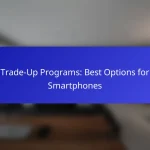What are the benefits of Trade-Up Programs?
Trade-Up Programs offer several advantages, including increased customer loyalty, enhanced product lifecycle management, improved sustainability practices, access to upgraded technology, and cost savings for consumers. These programs incentivize customers to exchange older products for newer models, creating a win-win situation for both businesses and consumers.
Increased customer loyalty
Trade-Up Programs foster customer loyalty by creating a sense of value and appreciation. When customers feel rewarded for their loyalty through trade-in incentives, they are more likely to return for future purchases. This ongoing relationship can lead to higher customer retention rates and increased lifetime value.
For example, a smartphone manufacturer may offer discounts on new models when customers trade in their old devices. This not only encourages repeat business but also strengthens brand allegiance.
Enhanced product lifecycle management
Trade-Up Programs improve product lifecycle management by facilitating the efficient return and refurbishment of older products. Companies can better track product performance and customer preferences, allowing for more informed decisions regarding future product development. This leads to optimized inventory and reduced waste.
For instance, a company may analyze trade-in data to identify which models are most frequently returned, helping them to enhance future designs or discontinue underperforming products.
Improved sustainability practices
By encouraging the return of older products, Trade-Up Programs contribute to sustainability efforts. These programs help reduce electronic waste by promoting recycling and refurbishment, which can minimize the environmental impact of discarded devices. Companies can highlight their commitment to sustainability, appealing to eco-conscious consumers.
Many businesses are now implementing take-back schemes that ensure old products are recycled responsibly, further enhancing their corporate social responsibility profile.
Access to upgraded technology
Trade-Up Programs provide consumers with easier access to the latest technology. By trading in older devices, customers can often afford to upgrade to newer models at a reduced cost. This makes advanced technology more accessible to a broader audience, enhancing user experience and satisfaction.
For example, a laptop manufacturer might offer a significant discount for trading in an older model, making it financially feasible for customers to acquire the latest features and performance enhancements.
Cost savings for consumers
Cost savings are a significant benefit of Trade-Up Programs, as they allow consumers to offset the price of new products with the value of their traded-in items. This can lead to substantial savings, especially for high-ticket items like electronics and appliances.
Consumers should compare trade-in values across different retailers to ensure they receive the best possible deal. Additionally, understanding the timing of promotions can maximize savings, as many companies offer limited-time trade-in bonuses.
How do Trade-Up Programs work in the US?
Trade-Up Programs in the US allow consumers to exchange their old products for discounts on new purchases. These programs incentivize recycling and upgrading by providing financial benefits to participants.
Step-by-step process overview
To participate in a Trade-Up Program, consumers typically start by checking the program’s eligibility requirements on the brand’s website. Once eligible, they can submit their old item for evaluation, which may involve filling out an online form or visiting a designated location.
After the evaluation, participants receive a trade-in value, which can be applied as a discount on their new purchase. Finally, consumers complete the transaction by paying the remaining balance, if any, and receive their new product.
Eligibility criteria for participation
Eligibility for Trade-Up Programs often depends on the type and condition of the item being traded in. Most brands require that the old product be in working condition, though some may accept damaged items at a reduced value.
Age restrictions may apply, as some programs only accept products that are within a specific timeframe of release. Additionally, consumers may need to provide proof of purchase for the item being traded.
Examples of participating brands
Several well-known brands offer Trade-Up Programs, including electronics manufacturers like Apple and Samsung, which allow customers to trade in old devices for credit towards new models. Automotive companies like Ford and Toyota also have similar programs, offering trade-in bonuses for older vehicles.
Retailers such as Best Buy and Amazon have established trade-in initiatives for various product categories, including electronics and home goods, making it easier for consumers to upgrade while being environmentally conscious.
What are the top Trade-Up Programs available?
The top Trade-Up Programs allow consumers to exchange their old devices for credit towards new purchases. These programs vary by brand and retailer, offering different values and processes for trading in used electronics.
Apple Trade In Program
The Apple Trade In Program enables customers to trade in their old Apple devices for credit towards a new purchase. The process is straightforward: users can check the estimated value of their device on Apple’s website, send it in, and receive credit based on its condition.
Apple accepts a range of devices, including iPhones, iPads, Macs, and even some non-Apple products. The trade-in value can vary significantly, often ranging from a few dollars for older devices to several hundred for newer models.
Samsung Trade-In Program
The Samsung Trade-In Program allows users to trade their old devices for credit towards new Samsung products. Customers can evaluate their device’s worth on Samsung’s website, and the program accepts a variety of smartphones and tablets.
Trade-in values can be competitive, with some devices fetching high credits, especially flagship models. Samsung often runs promotions that can increase the trade-in value, so checking for current offers is advisable.
Best Buy Trade-In Program
Best Buy’s Trade-In Program provides customers the opportunity to trade in a wide range of electronics, including smartphones, laptops, and gaming consoles. Users can obtain an estimate online or in-store, making it convenient to see potential credit before deciding.
The program offers flexibility, as customers can receive store credit or a Best Buy gift card. Values can vary, and it’s beneficial to compare offers from other trade-in programs to ensure the best deal.
How do Trade-Up Programs compare to traditional buyback options?
Trade-Up Programs typically offer better value and convenience compared to traditional buyback options. They allow consumers to exchange their old devices for credit towards new purchases, often providing higher trade-in values and a more streamlined process.
Higher trade-in values
Trade-Up Programs often provide higher trade-in values than traditional buyback schemes. This is because these programs are designed to encourage upgrades and retain customers, leading to more competitive offers. For instance, while a buyback might offer around 30-50% of the original price, Trade-Up Programs can sometimes exceed 60% depending on the device condition and model.
To maximize trade-in value, ensure your device is in good condition and check for any promotional offers that might boost the value further. Some programs may even provide additional bonuses for specific models or during promotional periods.
Convenience of online processing
Trade-Up Programs often feature online processing, making it easier for consumers to initiate trades from home. Users can typically complete the entire process online, from assessing the device’s value to receiving credit for their trade-in. This eliminates the need for in-store visits, saving time and effort.
When participating in online Trade-Up Programs, ensure you follow the provided instructions carefully. This may include cleaning the device, backing up data, and securely erasing personal information to avoid potential privacy issues.
Broader range of accepted devices
Many Trade-Up Programs accept a wider variety of devices compared to traditional buyback options. This includes not only smartphones but also tablets, laptops, and wearables. This flexibility allows consumers to trade in multiple types of devices in one transaction.
Before trading in, check the specific list of accepted devices for the program you choose. Some programs may have restrictions on age or condition, so understanding these criteria can help you avoid disappointment and ensure you receive credit for your items.
What are the prerequisites for joining a Trade-Up Program?
To join a Trade-Up Program, participants typically need to meet specific device condition standards, provide necessary documentation, and adhere to a defined timeframe for trade-ins. Understanding these prerequisites helps ensure a smooth trade-up experience.
Device condition requirements
Most Trade-Up Programs require devices to be in good working condition, meaning they should power on and function as intended. Common criteria include the absence of significant physical damage, such as cracks or water damage, and that all essential components, like the screen and battery, are operational.
Some programs may accept devices with minor cosmetic wear, while others might have stricter guidelines. It’s advisable to check the specific requirements of the program you are considering to avoid disappointment.
Documentation needed
Documentation typically required for Trade-Up Programs includes proof of purchase, such as a receipt or invoice, and any original packaging if available. Some programs may also ask for identification to verify ownership.
Having these documents ready can expedite the trade-in process. Ensure that all documents are clear and legible to avoid delays or complications.
Timeframe for trade-ins
Trade-in timeframes can vary by program, but most require devices to be sent in within a few weeks of receiving a trade-in quote. Some programs may offer a specific window, often ranging from 14 to 30 days, to complete the trade-in process.
It’s crucial to initiate the trade-in as soon as possible after receiving your quote to ensure you meet the deadline. Delays could result in a lower trade-in value or disqualification from the program altogether.
What are the emerging trends in Trade-Up Programs?
Emerging trends in Trade-Up Programs focus on enhancing customer engagement and streamlining the process of upgrading products. These innovations often leverage technology and partnerships to provide more value to consumers while simplifying the trade-in experience.
Integration with subscription services
Integration with subscription services is becoming a key trend in Trade-Up Programs, allowing consumers to seamlessly upgrade their products as part of a monthly plan. This model encourages loyalty and provides users with the latest technology without the burden of large upfront costs.
For example, a smartphone manufacturer might offer a subscription that includes regular upgrades every year, ensuring customers always have access to the latest models. This can be particularly appealing in markets where technology evolves rapidly.
When considering integration with subscription services, businesses should evaluate their pricing strategies and customer preferences. Offering flexible payment options and clear terms can enhance customer satisfaction and retention.




